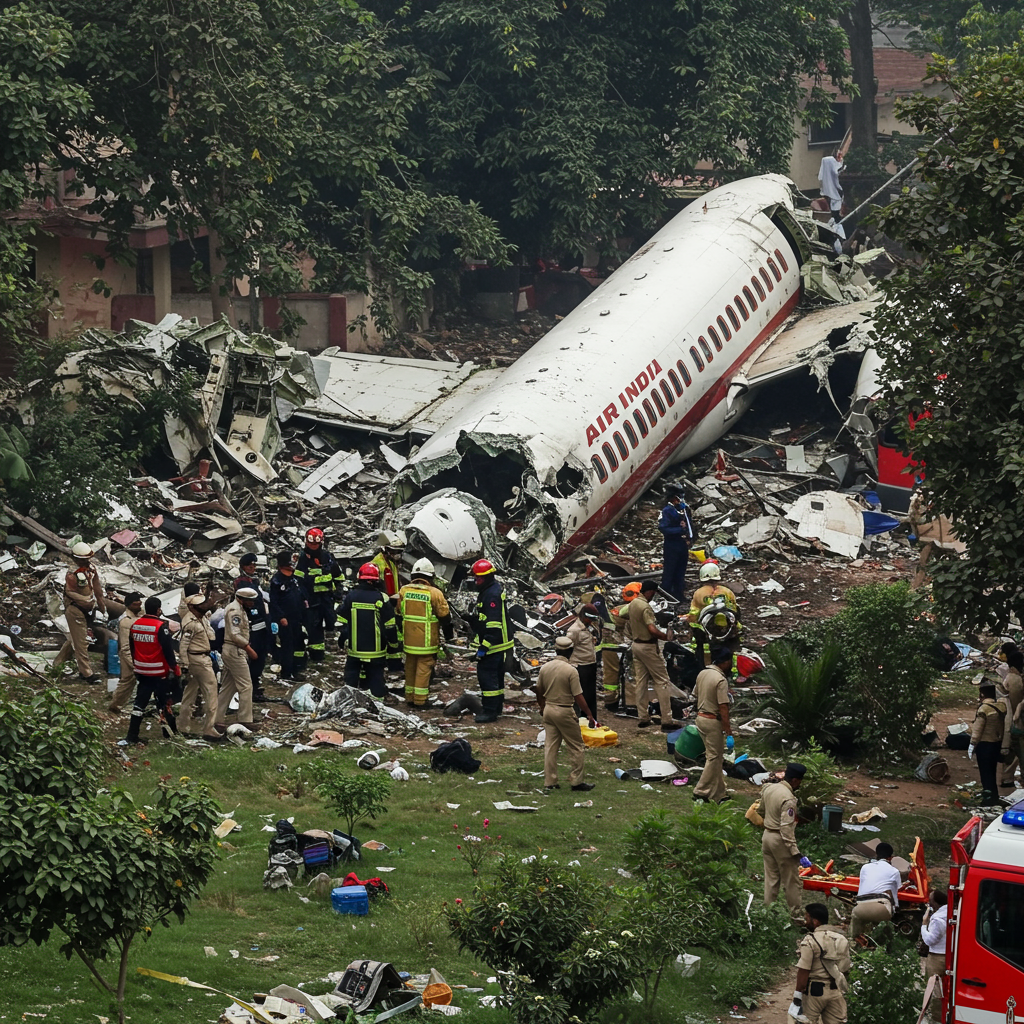Just 30 seconds. That’s how little time elapsed between Air India Flight AI171 lifting off the runway at Sardar Vallabhbhai Patel International Airport in Ahmedabad, India, and crashing into a nearby residential area on Thursday afternoon, June 12, 2025. The catastrophic incident involving the Boeing 787-8 Dreamliner, bound for London Gatwick, resulted in a devastating loss of life – claiming 241 people onboard, including multiple nationalities, and at least eight more on the ground. It marks the first fatal crash in the history of the 787-8 Dreamliner since its commercial debut in 2011.
The speed and severity of the disaster have left aviation experts and investigators searching for answers. While a definitive cause will only be determined by a comprehensive investigation involving teams from India, the US, and the UK, initial observations from video footage and expert speculation point to a sudden, critical failure occurring almost immediately after the aircraft left the ground.
The Flight’s Tragic, Brief Moments
Operated by Air India, the Dreamliner took off from runway 23 at 13:39 local time (08:09 GMT) carrying 242 people and reportedly a substantial fuel load of 100 tonnes – typical for a long-haul flight. Witnesses and authenticated footage show the plane struggling to gain altitude almost immediately after becoming airborne. The cockpit issued a Mayday call, signalling an emergency, but contact was lost moments later.
The sole survivor of the flight, a passenger, recounted hearing a loud bang as the aircraft fought to climb. Surveillance footage reviewed by BBC Verify confirms the jet was airborne for approximately 30 seconds, reaching a peak altitude of only around 625 feet (190 metres) before descending rapidly. The aircraft crashed just 1.5 kilometres (0.9 miles) from the runway, impacting residential buildings, including a hostel at the B.J. Medical College, causing significant destruction in the densely populated neighbourhood.
What Went Wrong? Key Theories Emerge
Investigators face the complex task of piecing together evidence from the crash site, the aircraft’s black boxes (Cockpit Voice Recorder and Flight Data Recorder), radar data, and witness accounts. Experts consulted by the media have offered several potential theories for what could cause a state-of-the-art aircraft to fail so quickly after takeoff:
A Struggle for Lift: Insufficient Thrust or a Stall?
Video analysis suggests the aircraft appeared “unable to climb,” struggling to gain altitude and perhaps flying with a high nose angle before descending. Aviation experts like Dr. Sonya Brown propose the aircraft may have stalled. A stall occurs when the wings lose sufficient airflow to generate lift, often due to low speed or an incorrect angle of attack relative to the speed. Without adequate engine thrust, speed drops, increasing the risk of a stall, especially at low altitudes and speeds typical of takeoff. Visual evidence suggests a potential lack of power or performance issue prevented the jet from achieving a safe climb profile.
Engine Failure Possibilities: Bird Strikes and Fuel Contamination
While the Boeing 787 is a twin-engine aircraft designed to operate on a single engine, a sudden loss of power from both engines simultaneously is a catastrophic scenario, particularly during takeoff. This is an exceptionally rare event, often referenced alongside the “Miracle on the Hudson” where a US Airways jet lost both engines after striking birds.
Bird strikes are a plausible theory being considered. Experts familiar with Ahmedabad airport note it is “notorious for birds.” Official data supports this, with hundreds of bird strike incidents reported in the state over five years, concentrated at the airport, and a notable rise in incidents there in 2022-23. While a single bird strike is rarely catastrophic, ingesting large birds into both engines could potentially cause simultaneous failure. The sole survivor’s report of a “loud bang” shortly after takeoff could align with an engine ingesting a bird.
Another potential cause for dual engine failure could be fuel contamination or clogging, starving both engines of the precise fuel supply they require, especially given the aircraft carried a near-full fuel tank. Engine manufacturer GE Aerospace is sending a team to assist the investigation into this possibility.
Takeoff Configuration: The Flaps Question
A critical element for generating sufficient lift at lower speeds, such as during takeoff, is the proper extension of wing flaps. For a heavily loaded aircraft departing in hot conditions – temperatures in Ahmedabad were near 40°C (104F), which thins the air and makes gaining lift more challenging – correct flap settings and high engine thrust are essential. Some experts have speculated whether the aircraft’s flaps were not extended correctly during takeoff, based on interpretations of the available video footage, though others caution the video quality makes this difficult to confirm.
Operating with retracted or improperly set flaps during takeoff would severely hinder the aircraft’s ability to climb. However, the Boeing 787 is equipped with a take-off Configuration Warning System designed to alert the crew to an unsafe configuration, including improper flap settings, before the takeoff roll is completed. Experts suggest that a failure to set flaps would be a “highly unusual” error given standard pre-flight checklists and procedures, potentially pointing towards human error if it occurred.
Broader Investigation Areas
Beyond these immediate theories, the investigation will encompass a wide range of potential mechanical issues, system failures (including power systems or potential engine computer programming issues), and human factors. While the pilots were highly experienced, investigators will examine crew background, health, and decisions made under pressure. The age and maintenance history of the 11-year-old aircraft will also be reviewed. Less likely possibilities, such as deliberate sabotage, are typically considered but are not currently viewed as probable causes by experts.
Why Low Altitude Was Critical
Regardless of the initial problem, the extremely low altitude achieved – just over 600 feet – was a critical factor in the catastrophic outcome. Modern aircraft possess multiple layers of redundancy and backup systems, including the ability to glide or use emergency power sources like the Ram Air Turbine (RAT). However, these systems require time and altitude to deploy effectively and for pilots to react and attempt a recovery. At the height and speed of the Air India flight’s struggle, there was simply insufficient time or airspace for the crew or automated systems to overcome a sudden, critical failure, making a survivable outcome virtually impossible.
The Investigation Ahead
The multi-national team of accident investigators has begun the painstaking process of examining the crash site and recovering key data. The analysis of the flight recorders and wreckage will be crucial in identifying the precise sequence of events and the root cause of this tragedy. The aviation community awaits the findings, not only to understand what happened in those fatal 30 seconds but also to potentially identify any previously unknown risks that could affect the safety of other flights worldwide. Meanwhile, the focus also remains on the immense human toll, remembering the many lives lost onboard and on the ground in Ahmedabad.




